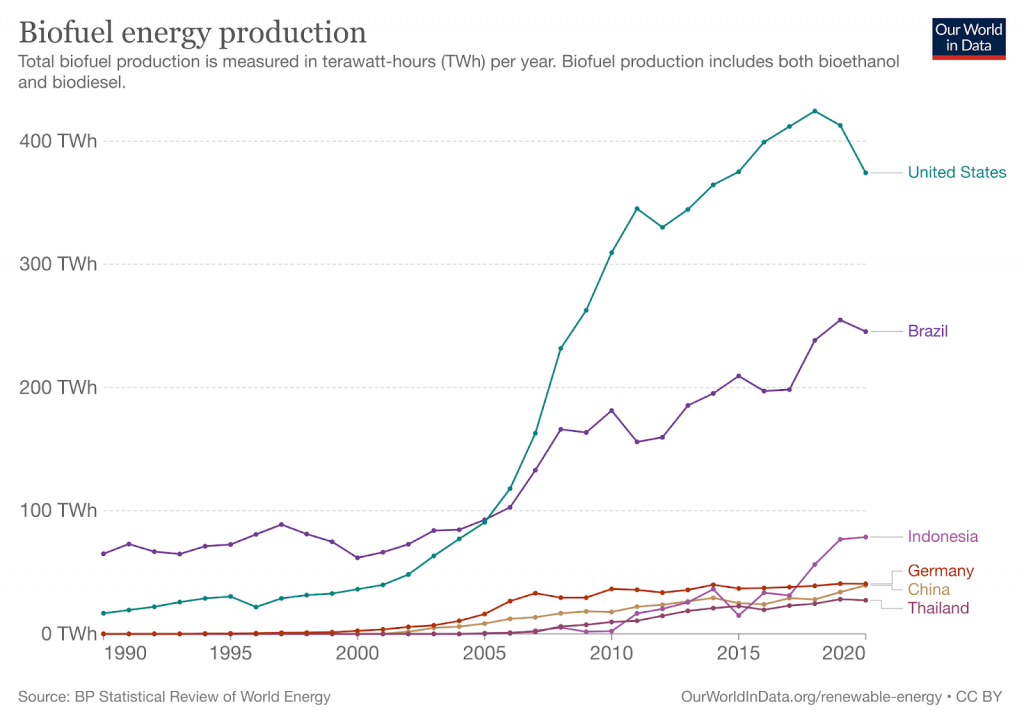What Is the Carbon Footprint of Biodiesel? A Life-Cycle Assessment
Impactful Ninja is reader-supported. When you buy through links on our site, we may earn an affiliate commission.
Learn more
Learn more
.
Hey fellow impactful ninja ? You may have noticed that Impactful Ninja is all about providing helpful information to make a positive impact on the world and society. And that we love to link back to where we found all the information for each of our posts. Most of these links are informational-based for you to check out their primary sources with one click. But some of these links are so-called "affiliate links" to products that we recommend. First and foremost, because we believe that they add value to you. For example, when we wrote a post about the environmental impact of long showers, we came across an EPA recommendation to use WaterSense showerheads. So we linked to where you can find them. Or, for many of our posts, we also link to our favorite books on that topic so that you can get a much more holistic overview than one single blog post could provide. And when there is an affiliate program for these products, we sign up for it. For example, as Amazon Associates, we earn from qualifying purchases. First, and most importantly, we still only recommend products that we believe add value for you. When you buy something through one of our affiliate links, we may earn a small commission - but at no additional costs to you. And when you buy something through a link that is not an affiliate link, we won’t receive any commission but we’ll still be happy to have helped you. When we find products that we believe add value to you and the seller has an affiliate program, we sign up for it. When you buy something through one of our affiliate links, we may earn a small commission (at no extra costs to you). And at this point in time, all money is reinvested in sharing the most helpful content with you. This includes all operating costs for running this site and the content creation itself. You may have noticed by the way Impactful Ninja is operated that money is not the driving factor behind it. It is a passion project of mine and I love to share helpful information with you to make a positive impact on the world and society. However, it's a project in that I invest a lot of time and also quite some money. Eventually, my dream is to one day turn this passion project into my full-time job and provide even more helpful information. But that's still a long time to go. Stay impactful,Affiliate Disclosure
Why do we add these product links?
What do these affiliate links mean for you?
What do these affiliate links mean for us?
What does this mean for me personally?
![]()
Every year the transportation industry emits a significant amount of carbon dioxide (CO2) into the air. Although gasoline and diesel fuel are still the two most widely used fuel sources, biodiesel has emerged as an alternative fuel source that promises lower levels of pollutants and climate change-fighting properties. So, we had to ask: What is the carbon footprint of biodiesel?
On a life-cycle basis, biodiesel has a low carbon footprint. One gallon of biodiesel emits 5.87 pounds (2,661 grams) of CO2 when combusted, and driving one mile on average emits 404 grams of CO2. Depending on the source, biodiesel can combat climate change and have various environmental benefits.
Keep reading to learn about the overall carbon footprint of biodiesel, its carbon footprint throughout its life-cycle, and how environmentally friendly it is.
Here’s What the Carbon Footprint of Biodiesel Is
The carbon footprint is one of the ways we measure the effects of human-induced global climate change. It primarily focuses on the GHG emissions associated with consumption, but also includes other emissions such as methane (CH4), nitrous oxide, and chlorofluorocarbons.
“Carbon footprint: the amount of greenhouse gases and specifically carbon dioxide emitted by something (such as a person’s activities or a product’s manufacture and transport) during a given period”
Merriam Webster
Basically, it is the amount of carbon emitted by an activity or an organization. This includes GHG emissions from fuel that we burn directly (e.g., heating a home, driving a car) and GHG emissions from manufacturing the products that we use (e.g., power plants, factories, and landfills).
Biodiesel is an alternative, cleaner-burning fuel than petroleum-based diesel fuel (petroleum diesel). It is a subset of biofuels (ethanol and biodiesel) that is made from biomass. Biomass is renewable organic material from plants and animals that can be used to produce a wide range of products including energy, everyday products that contain plastics, and fuel.
“Biodiesel: a type of fuel made from plant or animal material and used in diesel engines”
Oxford Dictionary
Like petroleum diesel, biodiesel is used in diesel engines, which use compressed air in a cylinder to ignite the fuel rather than a spark. Biodiesel can be blended with petroleum diesel in any percentage to produce finished biodiesel. Pure biodiesel is referred to as B100, and B20 (20% biodiesel and 80% petroleum diesel) is the most common blend. One gallon of biodiesel produces 74% less emissions than petroleum diesel, 2,661 grams of CO2 (gCO2) compared to 10,180 gCO2.
| Burning of biodiesel | Carbon footprint |
| Burning one gallon | 2,661 grams of CO2 emitted |
| Driving one mile (on average) | 404 grams of CO2 emitted |
| Per million British thermal units (Btu) | 162.8 pounds of CO2 emitted* *Value when burning B100 |
Global biodiesel production in 2019 was 41 billion liters, and this number is expected to increase to 46 billion in 2025.

Oil (including gasoline and diesel fuel) is the world’s primary fuel source for transportation. But since the turn of the century, there has been a push towards a cleaner-burning transportation fuel with less negative effects on the environment. This is one major reason the market for biodiesel is expected to increase from $141 billion in 2020 to $307 billion by 2030.
To understand the total carbon footprint of biodiesel, we must assess its life-cycle and each stage’s carbon footprint. This life-cycle assessment (LCA) is a method to evaluate the environmental impacts of products and materials. Over the years, companies have strategically used LCA to research and create more sustainable products. So, let’s have a look at the LCA of biodiesel!
| The life-cycle stages of biodiesel | Each stage’s carbon footprint |
| Building of biorefinery | CO2 emissions from building the components of the biorefinery |
| Extracting of biodiesel | CO2 emissions from the transesterification process |
| Transportation of biodiesel | CO2 emissions from transporting biodiesel by barges, tankers, pipelines, trucks, and railroads across distances |
| Building back of biorefinery | CO2 emissions from utilizing construction equipment to demolish the buildings and construct new buildings in the old biorefinery’s place |
The total carbon footprint of biodiesel would equal the carbon footprint from building + the carbon footprint from extracting + the carbon footprint from transportation + the carbon footprint from building back.
What Is the Carbon Footprint of Building a Biorefinery (a Biodiesel Refinery)
Biodiesel is one of many produced in biodiesel refineries (biorefineries). Biorefineries convert organic material into chemicals for making products that are otherwise made from fossil fuels.
“Biorefinery: a facility that processes biological material (such as crop waste) to produce fuel (such as ethanol and biodiesel), electricity, and commercially useful chemicals (such as succinic acid)”
Merriam-Webster Dictionary
Biorefineries have many components, and constructing these components requires machinery that emits CO2.
What Is the Carbon Footprint of Extracting Biodiesel
Biomass sources are extracted and converted to biodiesel via chemical conversion, specifically the process of transesterification. In this process, vegetable oil, animal fat, and grease are converted into fatty acid methyl esters (FAME), producing biodiesel.
Generally, 100 pounds of oil or fat reacts with 10 pounds of short-chain alcohol (methanol or ethanol) in the presence of a catalyst (sodium hydroxide [NaOH] or potassium hydroxide [KOH]) to form 100 pounds of biodiesel and 10 pounds of glycerin (or glycerol).
What Is the Carbon Footprint of Transportation of Biodiesel
In 2018, 160 billion liters (bl) of biofuels were produced globally from biomass. North and South America account for 75% and Europe 14% of global biofuel production.

The six largest biofuel-producing countries (amount per year) in the world are:
- United States – 374 billion kilowatt-hours (bKWh)
- Brazil – 245 bKWh
- Indonesia – 78 bKWh
- Germany – 40 bKWh
- China – 39 bKWh
- Thailand – 27 bKWh
Calculating the carbon footprint of biodiesel transportation involves knowing where the biodiesel is produced, where it is being consumed, and the distance between the two.
The world’s largest biodiesel refinery is the Neste Singapore Refinery. It has over 300 employees which help produce 1.3 million tons of biodiesel annually, serving customers in both Europe and North America. Transporting biodiesel from Singapore to the US, for example, is a 15,299 kilometer (km) (9,500 mile) transportation distance. Likewise, there is a 10,128 km (6,290 mile) distance between Singapore and Germany. The carbon footprint of transportation for these circumstances would be high because it is a long distance that would require multiple modes of transportation.
On the flip side, if biodiesel is produced in one country and is consumed in that same country, the transportation distance is much shorter and would require fewer modes of transportation, leading to a lower carbon footprint for this stage.
What Is the Carbon Footprint of Building Back a Biorefinery (a Biodiesel Refinery)
Since the first biodiesel refinery in the US only opened in 1996, there is not much historical data on their life expectancy available. As a guesstimate, the average age of today’s oil refineries is around 40 years. CO2 emissions at this stage occur when utilizing construction equipment to demolish the buildings and construct new buildings in the old refinery’s place.
What Role Does Biodiesel Play in Combating Climate Change
Biodiesel can play a crucial role in combating global climate change if sourced responsibly. B20, the most widely used form of biodiesel, can reduce emissions from carbon monoxide (CO) by 12.6%, hydrocarbons 11%, particulates 18%, and air toxics 12-20% although it may produce 1.2% more nitrogen oxide (NOx) emissions.
“Climate Change: changes in the world’s weather, in particular the fact that it is believed to be getting warmer as a result of human activity increasing the level of carbon dioxide in the atmosphere”
Cambridge Dictionary
Climate change is arguably the most severe, long-term, global impact of fossil fuel combustion. Every year, approximately 36 bt of CO2 are emitted from burning fossil fuels. 12 bt (34%) of this comes from oil. The carbon found in fossil fuels reacts with oxygen in the air to produce CO2 which warms the earth by acting as a heating blanket.
Reduced CO2 emissions from biodiesel combat climate change in the following ways:
- Increasing temperatures: Earth’s atmosphere has warmed 1.5℃ since 1880. This may not seem like a lot, but these degrees create regional and seasonal temperature extremes, reduce sea ice, intensify rainfall and drought severity, and change habitat ranges for plants and animals.
- Rising sea levels: Global sea levels have increased approximately 8-9 inches since 1880, displacing people living along coastlines and destroying coastal habitats. Roads, bridges, subways, water supplies, oil and gas wells, power plants, sewage treatment plants, and landfills remain at risk if sea level rise goes unchecked.
- Melting of sea ice: Since 1979 arctic sea ice has declined by 30%. Sea ice plays a major role in regulating the earth’s climate by reflecting sunlight into space and providing habitat for animal species. If all of the glaciers on Earth melted, sea levels would rise by approximately 70 feet, effectively flooding out every coastal city on the planet.
- Changing precipitation patterns: Extreme weather events (e.g., hurricanes, floods, droughts) are becoming more common and more intense. Storm-affected areas will experience increased precipitation and flooding whereas areas located further from storm tracks will experience decreased precipitation and droughts.
- Ocean acidification: The ocean absorbs 30% of the CO2 released into the atmosphere, which decreases the pH (increases the acidity) of the ocean. In the past 200 years, the pH of oceans has decreased by 0.1 pH units, which translates to a 30% increase in acidity. Aquatic life unable to adjust to this rapid acidification will die off. A prime example of this is coral bleaching, where coral expel the algae (zooxanthellae) living in their tissues as a result of changes in temperature, light, or nutrients.
Climate change results in global warming, when CO2 and other air pollutants absorb sunlight and solar radiation in the atmosphere, thereby trapping the heat and acting as an insulator for the planet. Since the Industrial Revolution, Earth’s temperature has risen a little more than 1 degree Celsius (C), or 2 degrees Fahrenheit (F). Between 1880-1980 the global temperature rose by 0.07C every 10 years. This rate has more than doubled since 1981, with a current global annual temperature rise of 0.18C, or 0.32F, for every 10 years.
Experts claim that to avoid a future plagued by rising sea levels, acidified oceans, loss of biodiversity, more frequent and severe weather events, and other environmental disasters brought on by the hotter temperatures, we must limit global warming to 1.5C by 2040.
The more we reduce CO2 emissions, the more we slow the rate of temperature rise, sea-level rise, ice melting, and ocean acidification. When these rates are slowed, the earth’s biodiversity does not have to struggle to adapt to temperature and pH changes. People will not be displaced due to the flooding of coastal areas. And icebergs will continue to provide climate regulation.
How Environmentally Friendly Is Biodiesel
The overall environmental friendliness of biodiesel depends on how it is made and from which source it is made.
“Environmentally friendly: (of products) not harming the environment.”
Cambridge Dictionary
Depending on the source and scale of biodiesel, it can be an environmentally friendly alternative to petroleum diesel that can help mitigate the effects of global climate change.
What Are Environmental Benefits of Biodiesel
If made from waste materials or used cooking oil and operated at a small scale, biodiesel comes with many environmental benefits.
- Improves air quality: Biodiesel produces 1.0%, 8.3%, and 13% of the agricultural nitrogen, phosphorus, and pesticide pollutants, respectively, per net energy gain. It can decrease GHG emissions between 56-96%, the equivalent of planting 1.9 billion trees. It can also cut global warming pollution by 80-90% when compared to petroleum diesel.
- Increases engine efficiency: Biodiesel yields 93% more energy than the energy used in its production.
- Reduces wastewater: Biodiesel production, compared to petroleum diesel production, reduces wastewater by up to 79%.
- Reduces hazardous waste: Biodiesel is nontoxic, biodegradable, and can reduce hazardous waste by up to 96%. It will degrade quicker in the case of an oil spill, and it will not cause as many environmental problems compared to petroleum diesel. It also degrades when it comes into contact with water.
Biodiesel can be an environmentally friendly alternative to petroleum diesel if waste material or used cooking oil is used.
What Are Environmental Drawbacks of Biodiesel
Some research suggests that by 2050, bioenergy (biomass and biofuel) could meet 20% of the world’s total annual energy demand. However, this is not sustainable because it would require using ALL of the world’s crop harvests, plant residues, timber, and grass consumed by livestock. This is why biodiesel cannot replace gasoline and diesel fuel as the world’s primary transportation fuel.
If made from unused cooking oil (canola, soybean, palm), biodiesel comes with environmental drawbacks. Some claim that biodiesel is carbon neutral because the plants that are the source of the biodiesel absorb CO2 as they grow, thereby offsetting the CO2 released when biodiesel is burned. But in some parts of the world, large swaths of forests have been cleared and burned to plant soybeans and palm trees. Dedicating land for the sole purpose of biofuel production leads to deforestation, which in turn expedites global climate change.
Our forests absorb 2.6 billion tons of CO2 every year. The main threat to them is deforestation, which occurs at roughly 10 million hectares (~ 25 million acres) per year. The world has lost more than 1/3 of its forest since the last ice age, which occurred about 2.6 million years ago. Trees combat climate change, purify the air, provide housing for millions of plant and animal species, protect against floods and water pollution, and improve mental health. Chopping these trees to make space for crops has a devastating effect on the environment because it reduces the amount of trees that can capture our CO2 emissions. Protecting forest habitats increases carbon sequestration and decreases the effects of global climate change.
The best way to avoid the environmental drawbacks associated with biodiesel is to avoid sources such as unused cooking oils and instead use sources such as waste products and used cooking oils. The scale of biodiesel production is also important to consider because the land needed to produce biodiesel is also needed for food and as carbon storage.
Final Thoughts
Depending on the source, biodiesel can be an effective alternative fuel source with many environmental benefits. It generally has a low carbon footprint across its building, extraction, transportation, and building back stages, and it emits less CO2 than gasoline and diesel fuel when burned. Improvements in air quality and reductions in both wastewater and hazardous waste help combat global climate change.
The best way to mitigate the environmental drawback of deforestation is to source biodiesel from waste products and used cooking oil (as opposed to unused cooking oil). Our health and our planet’s health would benefit if we used biodiesel sustainably.
Stay impactful,

Sources
- Britannica: Carbon Footprint
- United States Environmental Protection Agency: System of
- Registries
- Biodiesel: Biodiesel basics
- Office of Energy Efficiency and Renewable Energy: Biofuel basics
- US Department of Energy Efficiency and Renewable Energy: Alternative Fuels Data Center – Biodiesel – Clean, Green Diesel Fuel
- US Environmental Protection Agency: Greenhouse Gas Emissions from a Typical Passenger Vehicle
- International Energy Agency: Global biofuel production in 2019 and forecast to 2025
- Environmental and Energy Study Institute: Fossil Fuels
- GlobeNewswire: Biofuels Market Size Worth Around US$ 307.01 Billion by 2030
- Science Direct: Life-cycle assessment (LCA)
- MIT SMR: Strategic Sustainability Uses of Life-Cycle Analysis
- Merriam-Webster Dictionary: Biorefinery
- CleanEnergy.org: Biorefineries Fact Sheet
- US Energy Information Administration: Biomass Explained
- European Technology and Innovation Platform: Transesterification to biodiesel
- US Department of Energy Efficiency and Renewable Energy: Alternative Fuels Data Center – Biodiesel Production and Distribution
- World Bioenergy Association: Global Bioenergy Statistics 2020
- Our World in Data: Biofuel Energy Production
- Statista: Biofuel Production by Country 2020
- Neste: Singapore Refinery
- DistanceFromTo: Distance from Singapore to the United States
- DistanceFromTo: Distance from Germany to the Singapore
- Pacific Biodiesel: History of Biodiesel Fuel
- Canary USA: Are the Stresses of Middle Age Too Much for Today’s Refineries?
- World Nuclear Association: Carbon Dioxide Emissions from Electricity
- The National Wildlife Federation: Climate Change
- National Oceanic and Atmospheric Administration: Climate Change – Global Temperature
- National Oceanic and Atmospheric Administration: Climate Change – Global Sea Level
- United States Geological Survey: How would sea level change if all glaciers melted?
- National Aeronautics and Space Administration, U.S.A.: How does climate change affect precipitation?
- National Oceanic and Atmospheric Administration: Ocean Acidification
- National Ocean Service: What is coral bleaching?
- National Resources Defense Council: Global Warming 101
- United Nations Framework Convention on Climate Change: The Paris Agreement
- Iowa Renewable Fuels Association: Biodiesel and the Environment
- Proceedings of the National Academy of Sciences of the United States of America: Environmental, economic, and energetic costs and benefits of biodiesel and ethanol biofuels
- Union of Concerned Scientists: Biodiesel Basics
- US Energy Information Administration: Biodiesel and the Environment
- Farm Energy: Transportation and Storage of Biodiesel
- The Guardian: Biofuels are not a green alternative to fossil fuels
- ClientEarth: What is a Carbon Sink?
- Our World in Data: Deforestation and Forest Loss
- Food and Agricultural Organization of the United States: State of the World’s Forests 2020
- Woodland Trust: Why do we need trees?
- One Green Planet: How Saving Wildlife Benefits Humans – In Ways We Really Need
- US Environmental Protection Agency: Emission Factors for Greenhouse Gas Inventories




